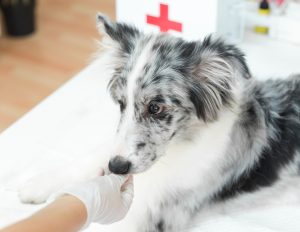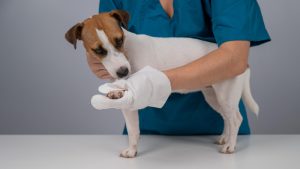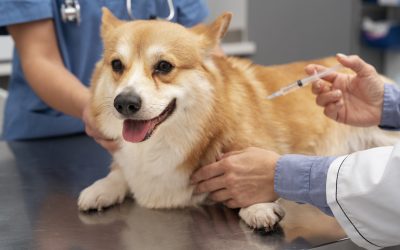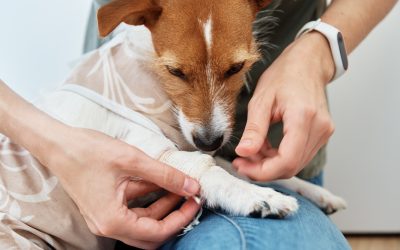How To Wrap a Dog’s Paw and Treat Open & Closed Wounds
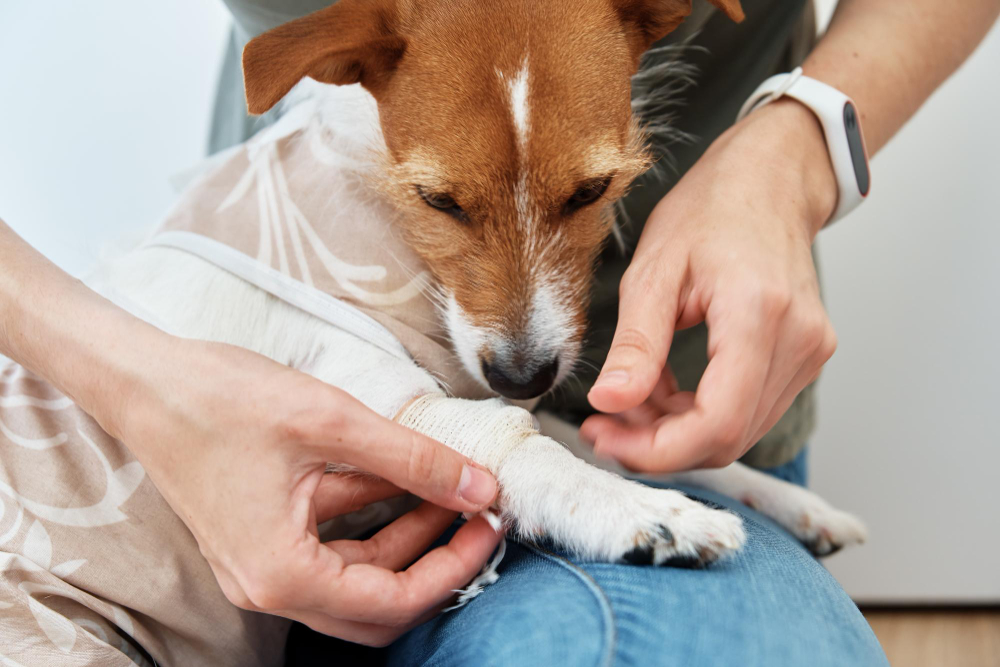
Updated October 13, 2025
You’re out on a hike with your dog, exploring a new trail. Your pup is darting around, full of energy, when suddenly, they yelp and start limping. You take a closer look and notice a small cut on their paw—nothing too serious, but it’s definitely something that needs attention. Knowing how to handle these kinds of situations can make all the difference in keeping your dog comfortable and preventing further injury.
Whether it’s a minor scrape, a deeper cut, or just some irritation from rough terrain, knowing how to properly care for your dog’s wounds is an essential part of being a pet parent.
This guide will walk you through the steps of basic dog wound care. We’ll also share some tips to help you handle those unexpected moments so you can confidently care for your pup and get them back to their usual, tail-wagging self.
Understanding The Different Types Of Dog Wounds
Each type of wound requires a different treatment. So, it’s vital to identify the injury:
Abrasions
Abrasions are superficial wounds. They damage the outermost skin layer and are often caused by scraping or rubbing against a rough surface. Abrasions can range from minor scratches to more extensive areas of skin loss.
Lacerations
Lacerations are deeper cuts for tears in the kind and are often caused by sharp objects or bites. These wounds can be clean or jagged and may involve damage to underlying tissues.
Puncture Wounds
Puncture wounds come from objects that penetrate the skin, such as nails, thorns, and animal bites. These wounds can be deep and require careful cleaning and monitoring to prevent infection.
Avulsions
Avulsions are when a portion of skin or tissue is torn away from the body. These wounds can be particularly challenging to treat and may require surgical intervention.
Burns
Burns can be caused by heat, chemicals, or electricity. The severity of a burn depends on the degree of tissue damage and the extent of the affected area.
Assessing The Severity Of A Dog Wound
It is best to follow these steps to assess the injury’s severity and determine the correct course of treatment.
- Observe the wound: Look closely at the wound and note its size, depth, and any visible debris or foreign objects. Watch for swelling, redness, or discharge, which may signal an infection.
- Check for bleeding. Assess how much bleeding there is, if it’s active, or if the bleeding has already stopped. Excessive or uncontrolled bleeding may require immediate veterinary attention.
- Consider the location: The location of the wound can impact its severity. Injuries near sensitive areas, like the eyes, ears, or joints, may need specialized care.
- Assess your dog’s behavior: Monitor your dog’s behavior and overall demeanor. Pain, lethargy, or unusual behavior may signal a serious issue.
Preparing For Dog Wound Care: Gathering Supplies.
Having the right materials can greatly impact the outcome and helps ensure effective and safe treatment. Here’s a list of essential supplies you should have in your dog’s first-aid kit:
- Gauze pads: Sterile gauze pads are crucial for cleaning and covering wounds. They come in various sizes, so having a variety on hand is best.
- Non-stick dressings: Non-stick dressings prevent the bandage from sticking to the wound, allowing for easier removal and less trauma.
- Adhesive Tape: Use adhesive tape or self-adhesive bandages to secure dressings and wraps. Look for pet-friendly options or hypoallergenic varieties.
- Antiseptic solution: An antiseptic solution, like chlorhexidine or povidone-iodine, can help clean and disinfect wounds before dressing them.
- Antibiotic ointment: A pet-safe antibiotic ointment can help minor wounds. It prevents infection and promotes healing.
- Scissors: Clean, sharp scissors are essential for cutting gauze, dressings, and bandages to the right size.
- Tweezers: Tweezers can help remove debris from wounds and should be easy to access.
- Gloves: Disposable gloves can protect you and your dog from infections while caring for wounds.
- Treats: Depending on your dog’s temperament, you may need a muzzle or high-value treats to ensure your dog’s cooperation and safety during dressing.
Step-By-Step Guide: How To Wrap A Dog’s Paw
One of the most common areas where dogs sustain injuries is their paws. A cut, abrasion, or puncture wound can harm a dog’s paw. Properly wrapping it can protect the injury, prevent further trauma, and promote healing. Here’s a step-by-step guide on how to wrap a dog’s paw:
- Prepare the area: Clean and light the workspace. Gather gauze pads, non-stick dressings, adhesive tape or bandages, and scissors.
- Clean the wound: Use an antiseptic and sterile gauze pads. Be thorough but gentle, as excessive scrubbing or probing can cause further damage.
- (Optional) Apply antibiotic ointment. For minor, non-puncturing wounds, antibiotic ointment can help. Make sure to use a thin layer of pet-safe ointment to heal and prevent infection.
- Cover the wound with a non-stick dressing or sterile gauze pad. The dressing must be large enough to cover the entire area.
- Wrap the paw: Use a self-adhesive bandage or gauze roll. Start by wrapping the paw from the toes to the leg. Overlap each layer by half the width of the bandage. Ensure the wrap is snug but not too tight, as you don’t want to restrict blood flow.
- Secure the bandage: Once at the desired height, carefully use tape or tuck the end under the last layer of the wrap to secure it.
- Monitor and adjust: Check the bandage to ensure it’s not too tight or causing discomfort. Adjust or replace the bandage as needed, and monitor for signs of infection or worsening of the wound.
Tips For Preventing Your Dog From Licking Or Removing The Bandage
Bandages and wraps protect wounds and aid in healing butut, but they can frustrate dogs. Many dogs instinctively lick or chew their bandages, complicating and delaying healing. To stop your dog from licking or removing their bandage, try these tips:
- Use an Elizabethan collar (cone): It’s the “cone of shame.” Blocking their head and neck prevents your dog from accessing the bandaged area.
- Distract with toys or treats: Give your dog engaging toys or long-lasting chews to divert your dog’s attention from the bandage.
- Bitter spray or deterrent: A pet-safe bitter spray can deter licking or chewing.
- Wrap or cover the bandage: A self-adhesive wrap or a pet-safe sleeve or sock can make it harder for your dog to reach the wound.
- Supervise and redirect: If possible, watch your dog. Redirect their attention if they start to lick or chew the bandage. Positive reinforcement and consistency are key.
How To Treat An Open Wound
Open wounds, like lacerations, punctures, or avulsions, need special care to prevent infection and aid healing. They expose underlying tissues and, if not treated properly, are more dangerous than closed wounds.
Here are some essential steps for open wound care in dogs:
- Control bleeding: If the wound is bleeding, apply gentle pressure with a clean, absorbent material. Do this until the bleeding slows or stops. Excessive or uncontrolled bleeding may require immediate veterinary attention.
- Clean the wound: Once the bleeding is under control, gently clean the wound using a mild antiseptic solution and sterile gauze pads. Be careful not to scrub or irritate the wound further.
- Flush the wound. Use sterile saline to remove debris and reduce infection risk for puncture wounds or deep cuts.
- Apply antibiotic ointment. After cleaning, use a thin layer of pet-safe antibiotic ointment on the wound. This will help prevent infection and promote healing.
- Cover and bandage: Cover the wound with a sterile, non-stick dressing and secure it with a bandage or vet wrap. This will protect the wound from further contamination and irritation.
- Monitor for signs of infection: Watch for signs of infection, such as increased swelling, redness, discharge, or fever. If any of these occur, seek immediate veterinary care.
- Change dressings regularly: Open wounds need frequent dressing changes. This keeps the area clean and promotes healing. Follow your veterinarian’s instructions on how often to change the dressings.
How To Treat A Closed Wound?
Closed wounds, like bruises and hematomas, injure tissues beneath the skin. Although they don’t break the skin’s surface and may seem less severe than open ones, proper care is essential to prevent complications and promote healing.
Here are some guidelines for caring for closed wounds in dogs:
- Apply cold therapy: For 24-48 hours after the injury, use cold therapy (an ice pack wrapped in a towel) on the affected area to help reduce swelling, inflammation, and pain.
- Monitor for signs of infection: Look for increased swelling, redness, warmth, or discharge, which may indicate that the wound is open or infected.
- Restrict activity: Limit your dog’s activity and movement to prevent further trauma or aggravation of the injury. Crate rest or confinement may be necessary in some cases.
- Provide pain relief: If your dog is in pain, your vet may suggest over-the-counter or prescription pain medications.
- Warm Compress: After 24-48 hours, apply warm compresses to the area to help reduce any swelling or bruising.
- Monitor for worsening or non-healing: If the wound worsens or does not improve, it may indicate a serious underlying issue, and seeking veterinary care is recommended.
When To Seek Veterinary Care For Your Dog’s Wound
Some minor wounds can be treated at home with proper care, but some situations require professional veterinary care. Understanding the severity of the wound will ensure your dog gets the right treatment.
Here are some instances when you should seek veterinary care for your dog’s wound:
- Severe or uncontrolled bleeding
- Deep or penetrating wounds to determine if sutures or surgery is required.
- Injuries near the eyes, ears, or joints may need special care and should be examined by a professional.
- A potential foreign object, like a splinter, in the wound
- Symptoms such as swelling, redness, or fever
- Non-healing wounds (not healing after several days of care)
- Severe pain or discomfort: See a vet for treatment if your dog is in severe pain despite at-home care.
- Puncture wounds, especially from animal bites or unknown objects
- Avulsions or severe tissue damage as they often need surgery.
- Dogs with diabetes or chronic illnesses may heal poorly and require closer monitoring by a vet.
Taking care of your dog’s wound at home usually won’t break the bank. You can often handle it yourself with a quick call to your vet or a telehealth service for advice. But if you need to take your dog to the vet for wound treatment, the cost can add up fast, ranging anywhere from $800 to $2,500, so it’s good to be prepared for those bigger expenses by having pet insurance.
FAQs
What supplies do I need, and when should I see a vet?
Supplies: Sterile gauze, non-stick dressings (Telfa pads), self-adhesive bandages (Vet Wrap), adhesive tape, antiseptic (2% chlorhexidine or povidone-iodine), pet-safe antibiotic ointment, scissors, tweezers, gloves, cotton padding, E-collar.
See vet for: Uncontrolled bleeding (10-15+ minutes), deep/jagged cuts needing stitches, large wounds (>½ inch), puncture wounds/bites, embedded foreign objects, wounds near eyes/nose/ears/mouth/genitals, infection signs (redness, swelling, pus, odor), burns, open fractures, or severe pain/lethargy.
How do I clean a dog’s wound?
Wear gloves. Flush with clean water to remove debris. For paws, swish in warm soapy water or spray with a hose. Remove visible debris with tweezers (only if easily accessible). Clean with mild antiseptic using sterile gauze—be gentle. Pat dry completely. Trim fur around the wound (use KY jelly to trap pieces). Clean 1-3 times daily for the first 3 days, then every 2-3 days. Avoid alcohol and hydrogen peroxide—they slow healing.
How do I wrap a dog’s paw step-by-step?
- Clean and dry the wound thoroughly.
- Place non-stick gauze pad over wound with thin antibiotic ointment.
- Add gauze pads to cushion the paw pad.
- Wrap with cotton roll padding.
- Starting at toes, wrap with self-adhesive bandage (Vet Wrap) up to and including ankle/wrist joint.
- Wrap snugly but fit 2 fingers between bandage and leg.
- Secure with tape.
- Cover with a sock/bootie/plastic bag when outside. Change bandages daily.
How do I stop bleeding and what are signs of problems?
Apply gentle, direct pressure with a clean cloth for 5-10 minutes without lifting. A cold compress helps. If bleeding continues after 10-15 minutes, seek emergency care. Apply a pressure wrap for transport.
Infection signs: Redness/swelling, excessive pain, red streaking, pus (yellow/green discharge), foul odor, hot to the touch, fever, lethargy.
Circulation problems: Swelling beyond the bandage, discoloration (pale/blue/purple), coldness, and increased pain. Remove the bandage immediately and contact your vet.
How do I prevent licking, and how long does healing take?
An Elizabethan collar (cone) is the most effective. Alternatives include inflatable collars, recovery suits, pet-safe sleeves/socks, and bitter apple spray. Excessive licking causes irritation, reopens cuts, introduces bacteria, delays healing, and leads to infections.
Healing time: Minor cuts 2-3 weeks, deeper wounds 4-6+ weeks, paw pad injuries longer (dogs walk on them). Inspect daily, take photos to track progress. Slower healing in older/diabetic/immunocompromised dogs.
What about specific wound types, and does insurance cover treatment?
- Paw pad cuts: Clean the area, control bleeding, apply a pad/wrap from toes to ankle, and change daily for 2-3 weeks. Often need vet care.
- Burns: Cool with cold water (heat) or rinse under water (chemical). Contact vet—need antibiotics/bandaging.
- Puncture wounds: Clean surface, don’t probe. Always need vet—easily infected, may need antibiotics/surgical cleaning.
- Insurance: Most policies (like Odie’s) cover accidental injuries, including emergency visits, wound cleaning, bandaging, medications, and surgeries. At-home treatment costs $20-50; vet care costs $100- $300+, depending on severity.

